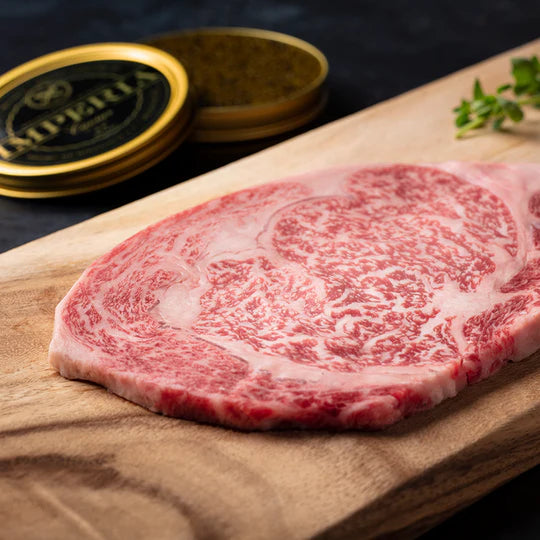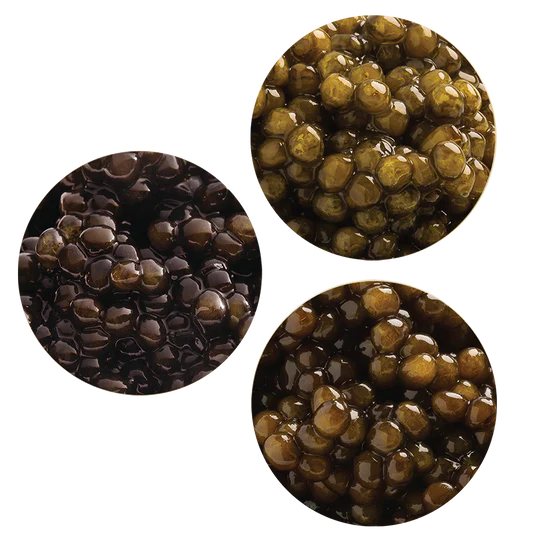To fully enjoy caviar, we must engage all of our senses. Taste, smell, and touch are all obvious, and some say that the distinctive “pop” of caviar pearls can even be heard if you listen closely enough.
But what caviar newcomers tend to overlook is the visual aspect of this delicacy. What does the caviar look like, what indicators tell us that it’s a quality product, and what does the color reveal about the taste and texture you can expect from your next bite?
Caviar color is a surprisingly important part of the caviar experience, and we can learn so much just by examining the colors of the pearls on our spoon. Today, we’re discussing the many colors of caviar, why they’re significant, and some red flags to avoid when shopping for caviar of your own.
Let’s get started.
BLACK VS. RED CAVIAR
You may imagine all caviar to have a jet black exterior, or maybe you’ve seen red and orange roe on your plate and believed it to be authentic caviar.
Don’t be misled, however — real sturgeon fish caviar has a few key characteristics that separate it from regular roe and put it in a category of its own.
Here’s what you should know:
AUTHENTIC BLACK CAVIAR
If you’ve seen caviar in movies and magazines, you’ll know that in most cases, the pearls are black as can be, with few other colors involved. There's even a black paint color named after this type of caviar, despite the vast number of colors found in caviar across North America, Europe, and Asia.
While the media's black caviar isn’t an inaccurate representation of the food, black caviar is only one part of a much bigger picture. The reason black caviar is so commonly depicted in media is due to its distinctive and intriguing exteriors of the physical egg, often used to contrast with other colors and interiors on the screen or page.
In other words, it’s much easier for art directors and photographers to convey the elegance of caviar to an audience when it’s pure black.
But here’s the truth about black caviar: only a handful of caviar products are truly 100% black in color. Authentic caviar can range in colors from black, brown, gray or gold. Each species of sturgeon can have a different color caviar.
Many of the products you encounter do not technically qualify as real caviar, such as American caviar, for instance. Paddlefish caviar is a popular product with a more manageable price tag than European and Middle Eastern caviars, but since it doesn’t come from a species of the sturgeon family, the caviar name isn’t accurate. American Hackleback caviar, however, does come from sturgeon roe and has a jet-black color.
Other jet-black roes like Capelin and Lumpfish are also sometimes given the title of caviar, but once again, it’s not a proper description of the product because it comes from a species of fish other than sturgeon.
This isn’t to say that these popular roes aren’t tasty or enjoyable – they all have their time and place. Our only point is to say that just because of their color, texture, and taste, they can’t be considered real caviar, and you should know what you’re buying every single time.
RED (ORANGE, AND YELLOW) CAVIAR – DOES IT COUNT?
Another point of confusion comes in the form of red, yellow, and orange roe, which are commonly mistaken for caviar as well.
These are the bright, neon colors found in products like salmon eggs, carp roe, whitefish, and trout caviar, as well as tobiko (flying fish roe). Once again, these are all wonderful products at attractive prices, but they simply aren’t real caviar due to their species of origin.
Keep in mind that when roe features unusual, unnatural colors, it typically means the product has been flavored with other ingredients like ginger, yuzu, wasabi, or chili pepper. If you’ve got a spicy roe on your hands, be sure to have a beverage nearby!
Furthermore, if you see any of these products with a caviar label, always look at the rest of the label so that you don’t get duped into buying something that isn’t authentic caviar.
BEYOND BLACK CAVIAR – OTHER NOTABLE COLORS
We’ve made the important distinction between true caviar and standard fish roe, as well as the colors to look out for. But when we drill deep into the category of real caviar, we see a new spectrum of unique colors to discover and understand.
Here are some of the colors you can expect to see from authentic sturgeon caviar, what they mean, and which species tend to produce them.
SILVER AND GRAY CAVIAR
Upon close inspection, you’ll see that most true caviar pearls have some variation of silver and grey color. Generally speaking, the lighter the grey and shinier the silver, the more mature the sturgeon, indicating a higher grade of quality in the caviar itself.
Beluga caviar, for instance, is arguably the most desirable and exclusive caviar in the world. Roe from the Beluga sturgeon features steely grey pearls and a signature shiny exterior.
Kaluga caviar, on the other hand, has a deeper, glossy grey color, with hints of other tones like gold, amber, and olive green.
You’ll also find a range of intriguing pearl and charcoal grey colors in the beads of Sevruga caviar, another one of the major caviar species. Sevruga sturgeon originate from the shallow waters of the Middle East and Russia.
In other words, the finest caviars on the planet are rarely pure black in color – silver and grey tend to be far more common and convey a higher level of quality for your enjoyment.
JADE AND GREEN CAVIAR
It might seem strange to detect shades of green in your caviar, but that doesn’t mean it has been flavored with wasabi.
Green is more of a secondary color in famous caviar products, but it’s present nonetheless. This could mean that the sturgeon was fed on more of a vegetarian diet or that it was younger when it gave the eggs.
We often hear fine caviar described as “earthy,” “woodsy,” or “herbaceous,” so it makes sense that there would be some green influence in our favorite caviar products.
AMBER, GOLD, AND BROWN CAVIAR
A more common caviar palette would be variations on brown, especially with shiner versions of bronze, copper, gold, and amber.
Some of the best caviars on the market feature exquisite shades of brown that look more like precious metals from deep in the earth, once again reminding us of their luxury.
Royal Ossetra caviar has a bit of everything in terms of color, with a base level of amber and plenty of bronze, jade, and jet-black hints to create a very balanced and elegant appearance. Paired with natural colors like reds, purples, and blue elements, this caviar can be as visually stunning as it is delicious.
As you build up your knowledge of caviar and try different types, be sure to take note of the colors and make connections to the taste and overall enjoyment of the product.
OTHER QUALITY INDICATORS
The beauty of great caviar is that every batch is slightly different in color, even if it’s from the same sturgeon or farm.
Here are some other variables that will impact the quality of the caviar and your experience in general.
FRESHNESS
No matter what kind of caviar you desire, freshness is king. The caviar color will be more vibrant when the product is fresh, as will the textures and flavors in each bite.
Always buy caviar from reputable vendors and store it properly in the cold part of your refrigerator to maintain freshness. After the seal is popped, be sure to consume it all within a few days.
AQUACULTURE
For a consistent, reliable color and quality, buy your caviar from vendors using the most advanced aquaculture practices to raise sturgeon and harvest eggs.
This will reduce the number of uncontrollable variables and give you a quality product every time, in color and all other aspects.
A COLORFUL STORY
The color of caviar is important and can tell you quite a bit about the product! Keep these tips in mind as you enjoy caviar at home, in restaurants, or anywhere you go.
Sources:
Eco-Friendly Farms | The Caviar House



